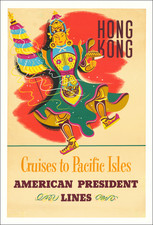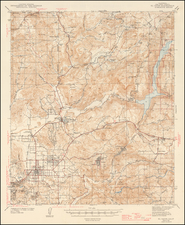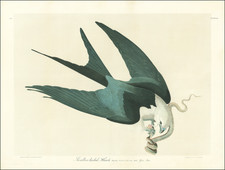From Naval Air Strip to the El Cajon Boulevard / Drag Strip Riot of August 1960
Rare promotional broadside poster, advertising a short-lived San Diego racetrack.
Hourglass Field holds a colorful if ephemeral place in San Diego history, beginning with its use as a practice area for aircraft carrier landing training during WWII, to its brief history as a race track in the late 1950 and subsequent flashpoint for the Drag Strip Riot of August 20 and 21, 1960.
Hourglass Field History
Hourglass field was located just west Interstate 15, about three miles north of Marine Corps Air Station Miramar. It was formerly known as Linda Vista Mesa Field and, later, Navy Outlying Field (NOLF) Miramar or Miramar Field / #01715 (OLF).
From late 1931 to 1941, it was just a square clearing with an east-west runway. The popular name comes from the layout of the airport's runway system, which was a single piece of asphalt mostly in the shape of an hourglass (3 overlapping runways) which started construction in late 1941 and completed February 1, 1942. The hourglass field was primarily used for carrier landing practice during World War 2.
Around the time of World War II the Navy used the surrounding area as a bombing range. The Army also used the area as a test area.
Auto Racing and The Drag Strip Riot
In 1956 the Navy made the airfield available to the San Diego Junior Chamber of Commerce and the San Diego Region Sports Car Club of America (SCCA) for automobile racing. In 1957 a 1.8 mile track was laid out and the California Sport Car Club and San Diego Region SCCA staged races there for three years as part of the regional road racing circuit. The field was also used for motorcycle racing and unauthorized drag racing.
When the Paradise Mesa drag strip closed in 1959, racers in San Diego turned to Hourglass Field. The Navy did not condone the unsanctioned drag racing taking place, but they did little to halt it.
The riot began during the evening of August 20, 1960 as an organized protest over the closing of Hourglass Field, an unused United States Navy airfield, to drag racing. The drag racing had been organized by the San Diego Timing Association, a local group of hot rod clubs, but was unauthorized. The Navy and the police looked the other way because Hourglass Field was the only off-street venue available for drag racing at the time.
On August 8, 1960, three or four bystanders were injured during a drag race. Already under pressure to crack down on the drag racing and shut down the airfield to drag racing, the Navy shuddered the field. Car clubs lobbied the city for an official drag racing site but were denied as the San Diego Police Chief A.E. Jensen said "Drag strips actually stimulate highway recklessness among those viewing such contests".
A protest was organized and thousands of fliers were spread around town at coffee shops, car clubs, movie theaters and other places. These fliers stated that there would be a "mass protest meeting" on El Cajon Boulevard on Sunday August 12. The news was also spread by a DJ named Dick Boynton on the local radio station. Two days later the police arrested a printer by the name of Herbert Sturdyvin, 20, on suspicion of conspiracy of printing the fliers that were used to organize the protest. He was released two days later without charges.
This led to an organized mass protest the night of August 20 and 21 at the intersection of El Cajon Boulevard and Cherokee Street in San Diego. A crowd of about 3,000 blocked several blocks of El Cajon Boulevard and began holding impromptu drag races. Around 2 A.M. more than 65 police officers responded, ordering the crowd to disperse and then moving in with tear gas and riot sticks. Some protestors tried to fight back by throwing coke bottles and rocks at the police and trying to overturn police cars. It took 3 hours to control the mob and two police officers were hurt during the course of the night. 116 demonstrators were arrested. The next night several drag racers drove around town taunting the police. This led to a further 100 people being arrested.
After the riot, the City of San Diego promised to form a committee to look into the problem of a lack of drag racing sites. The president of the National Hot Rod Association also pledged support. Eventually, all of these pressures came together and two new Drag racing strips were opened. The San Diego Raceway opened in Ramona in 1963 and the Carlsbad Raceway opened in 1964.
The San Diego Union called referred to the event at the "Drag Strip Riot" and socialists the riot one of the first major youth riots of the 1960s.
Post Race Track History
Sometime after the riot the Navy cut trenches across the Runways at Hourglass Field. The field was no longer useful for any kind of racing but became a popular spot for radio-controlled model aircraft, especially thermal soaring gliders flown by members of the Torrey Pines Gulls R/C Soaring Society, through the 1980s. In 1969 Miramar College opened on the site of Hourglass Field as a training facility for San Diego law enforcement and firefighting personnel. The site is now a small part of the large San Diego community of Mira Mesa.
Most of Hourglass Field is now gone. As of 2006 the northern edge of the hourglass still existed adjacent to the north side of the police/firefighter driving course. The southern edge of some baseball/softball fields paralleled the edge of runway 3/21, east of the indent of the "hourglass", separated by approximately 40 feet. The remaining surface of this part of runway 3/21 was used as a parking lot for the baseball/softball fields. As of 2012 only a small triangle of the original asphalt remains, from runway 13/31, as part of an open field adjacent to Black Mountain Road. Hourglass Field Athletics Complex now sits on the east end of the runway 3/21 location. Its grass plaza has narrow cobblestone features that outline an "X" and a bar reminiscent the runway layout.
Rarity
We were unable to find another example of the broadside.












![(Mississippi Bubble) De Lachende Ezopus op het koolmaal gehouden ter afscheyd van de Actieapen [The Laughing Aesop held at the cabbage feast as a farewell to the Action Monkeys.]](https://storage.googleapis.com/raremaps/img/small/94492.jpg)
![[Schoolchild's Map]](https://storage.googleapis.com/raremaps/img/small/80735.jpg)
![(Mississippi Bubble) De Eklips der Zuider Zon doet veele in 't duister zitten Veroorzaakt door de onpolitike Maan der Brn... [The Eclipse of the Southern Sun leaves many in the dark, caused by the unpolitic Moon of the Brn...]](https://storage.googleapis.com/raremaps/img/small/96163.jpg)